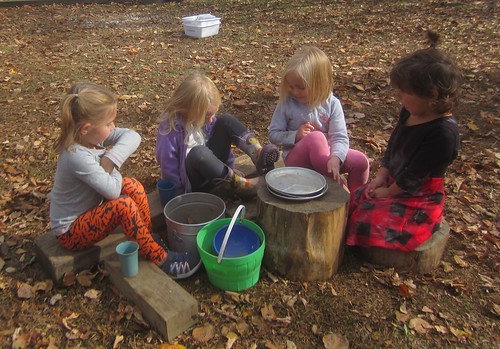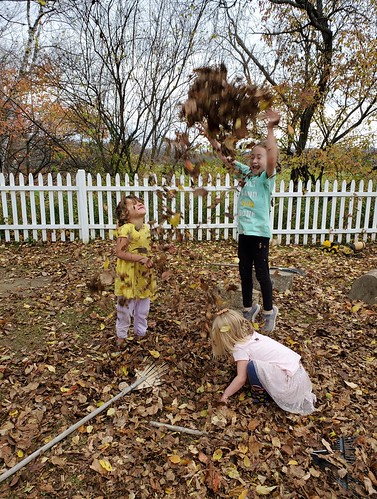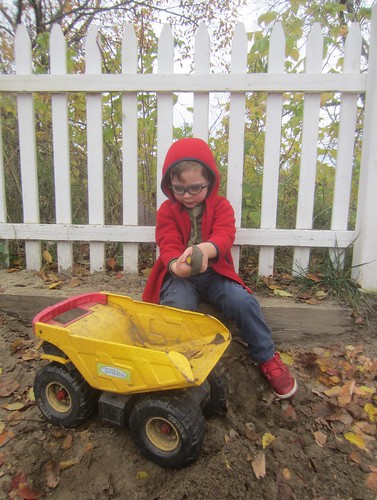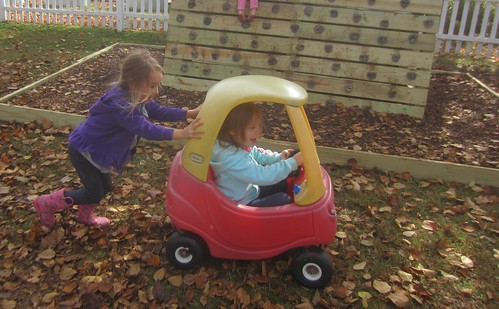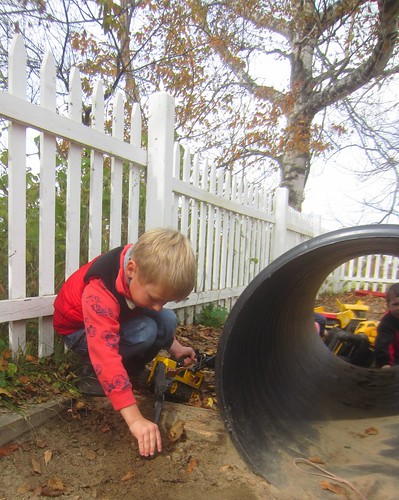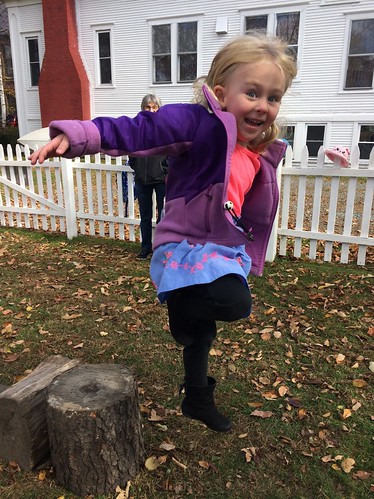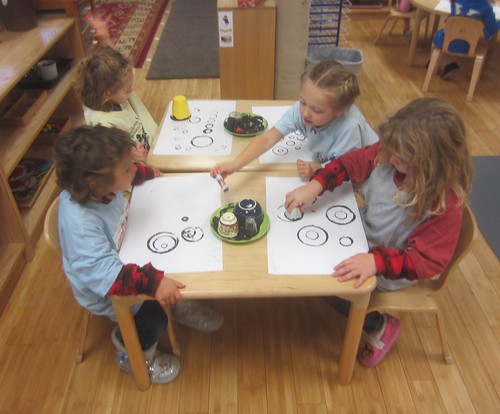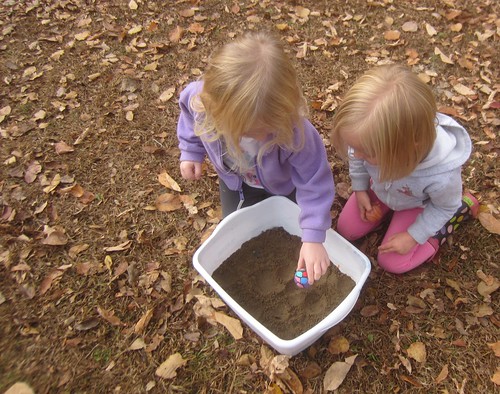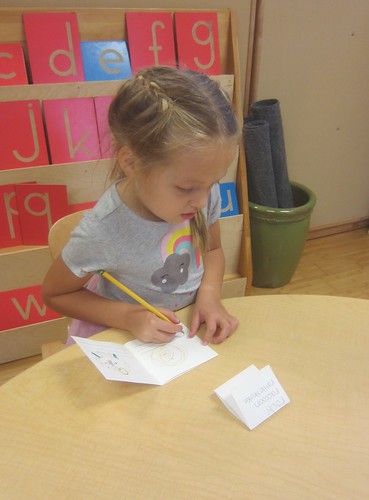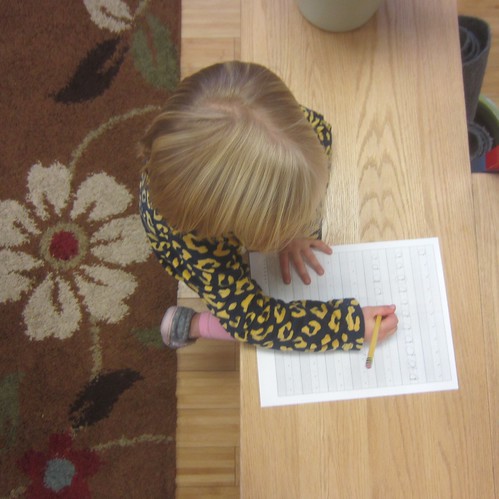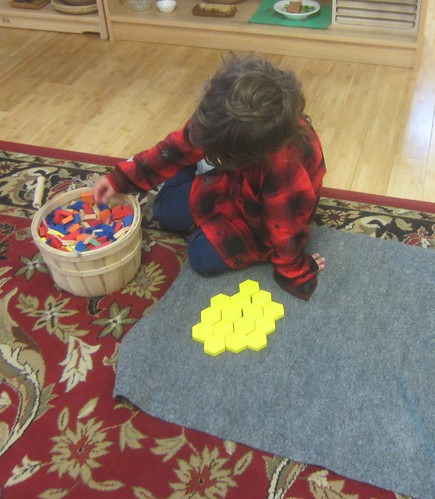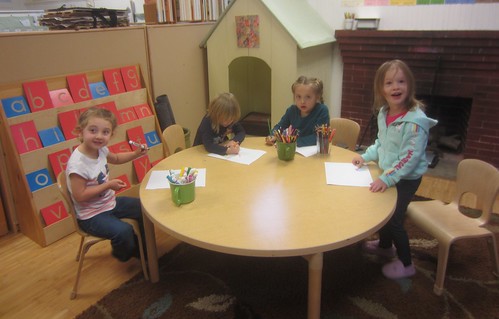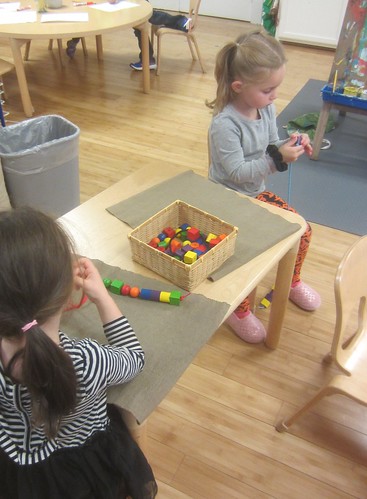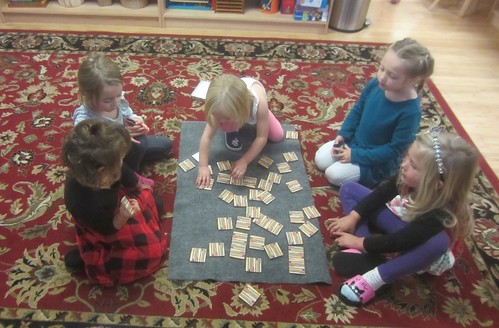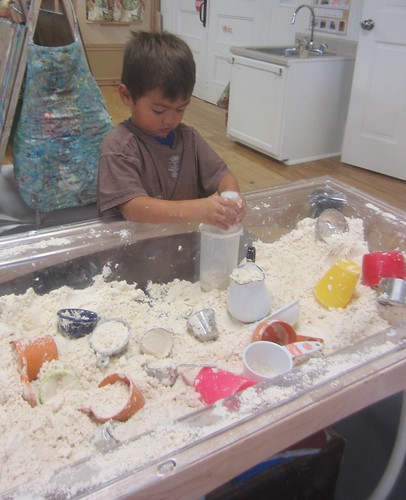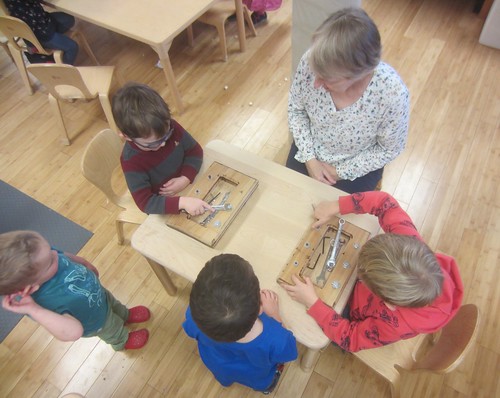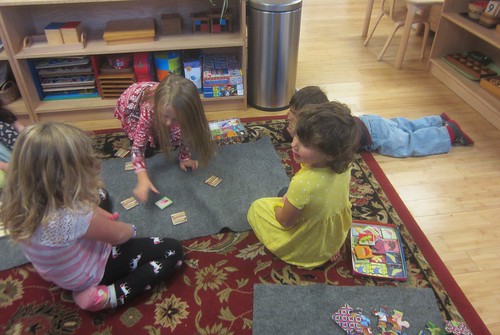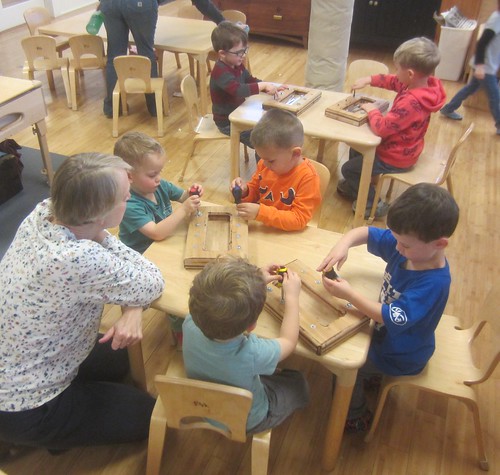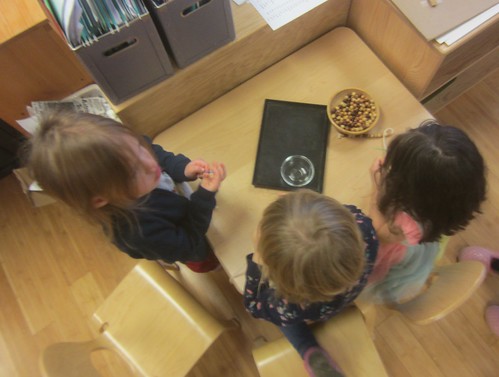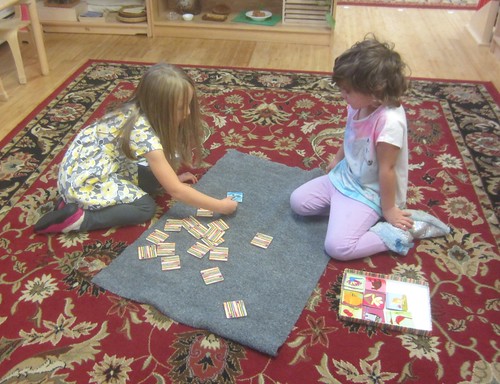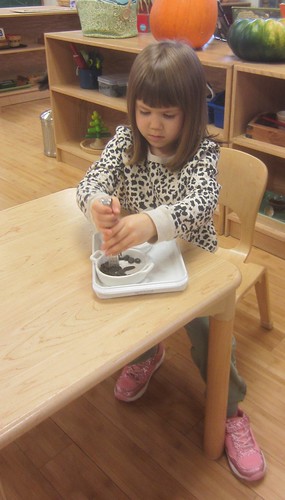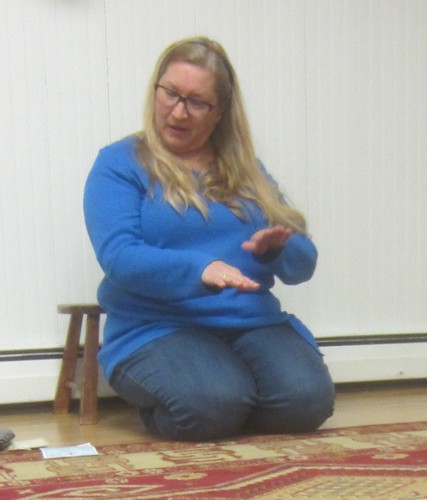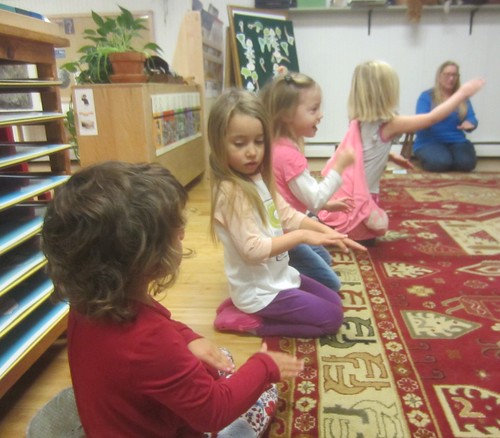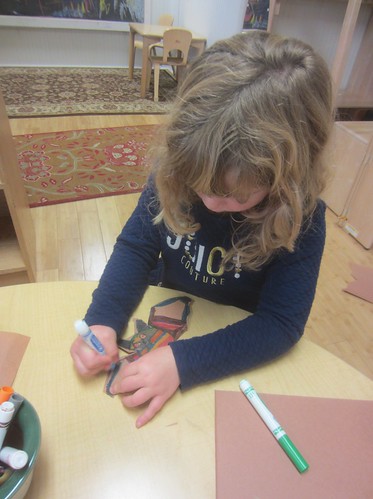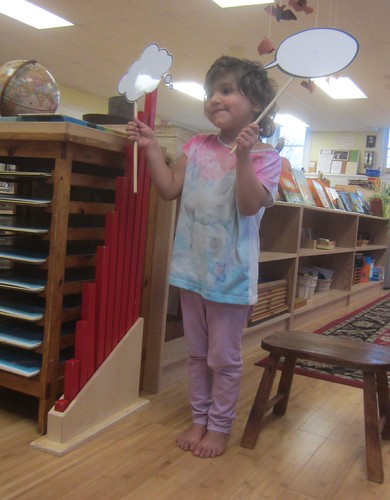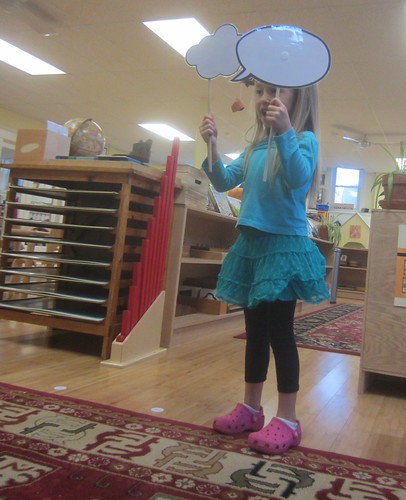Our chilly mornings led to warmer days, some with sunshine, others with clouds and rain. We raked up wet brown leaves and hauled them away, created obstacle courses, played chasing games, climbed up and over and sideways, played some soccer, and pretended to be police and bad guys.
Wassily Kandinsky, who is known for his painting Square with Concentric Circles, inspired our circle art this week. We used various sized circle cups, covers and containers to print black circles on paper. Next week the children will use bright colors to fill in the circles.
Tammy continued to guide children while they created their moon phases charts, first painting their two plates black, cutting a notch in one, punching out the moon phases, matching and pasting them around the plate in the proper order, then connecting them with a brad. It was a lot of work and they accepted and completed the challenge!
The book The Moon, by Gail Gibbons, began a discussion of what the moon is and is not. Our moon education continued with a brief video by National Geographic, titled Moon 101 (which was really a more advanced review of what we learned in the book, but with video visuals). We read that the moon is made of rock and dust and is the only (natural) space satellite orbiting the earth. We learned that it is the most visible light in the night sky because although it is not the biggest, it is the closest to the earth, and although it does not create its own light, it reflects the light from the sun, making it appear to shine. We learned that the moon takes about 1 month to orbit the earth, and the same side always faces earth, so we never see the back, or dark side, of the moon. We also learned that astronauts landed on the moon for the first time 50 years ago, and they left footprints that are still there today because there is no wind or rain on the moon. With no atmosphere to filter the sunlight, there is no blue sky on the moon, just black space. We looked at pictures, and watched a snippet of a video recording the moon, and observed all the craters covering the moon. We learned that asteroids and meteorites hit the moon, creating craters. Because there is no atmosphere to protect it, unlike Earth, and because there is no wind, rain, vegetation, or volcanoes, etc. the craters remain as they are for billions of years.
During Tuesday outside time we took some pans with various types of materials/surfaces, and some “asteroids” (balls) and tested to see what happens when we drop or throw them. We made hypothesis about what would happen then tested to see if our hypothesis were accurate. We tested using light, medium, and heavy balls, both dropping and throwing, on wet sand, flour, moon sand (flour & baby oil), and play dough. We observed that when we threw asteroids at the flour, it poofed up and out and created nice round craters. The moon sand seemed to most resemble what happens on the moon, pushing round craters down and sometimes fracturing out around them. The play dough barely dented, and the sand made craters if we threw the heavier balls quite hard.
We took a practice tour of the classroom to see how we would guide our families around the room on Thursday evening and introduce them to our room and all the materials we enjoy using. We had fun pretending to be Lyn’s family and asking her questions about her classroom. There were some really thoughtful questions!
We read some stories about friendship, including Friends, by Helme Heine and Hello Hello, by Brenden Wenzell. We discussed what a friend is. What makes a good friend? What do good friends do? The children shared that good friends play together, talk and listen to each other, play chase, take walks, share, build with blocks, etc. We sang the friendship songs Make New Friends and The More We Get Together.
The Halloween songs Stirring Our Brew, Five Little Pumpkins, and The Ghost of John were introduced. We all really liked the silly one about the skeleton ghost, John, who gets chilly with no skin on! We read the Halloween stories Room on the Broom by Julia Donaldson, The Little Old Lady Who Was Not Afraid of Anything, My Neighbor is a Witch, and Inside a House That Is Haunted.
During Sign Language with Rose we learned some action signs for school. First Rose demonstrated a sign where she held out her palm, then used two fingers from her other hand to scan up and down her palm. When she asked the children what they thought that sign might be, they had several guesses, finally naming “reading,” the sign she was making. We also learned walk, which is hands walking, run, which looks like our fingers running, share, which is made by holding the hand facing you with the thumb up and sweeping the opposite hand along the L made by the palm and thumb, and play, folding in the middle fingers with the thumbs and pinkies out, then shaking them.
We celebrated a fifth birthday on Thursday with tasty peanut butter cup peanut butter cookies. The birthday girl grinned happily while quickly orbiting the candle sun five times with the globe while we listed the seasons for each rotation. After the Happy Birthday song she blew the candle out in one try! Happy birthday, 5 year old!
Thursday evening was Bring Your Family to School Night. The children enjoyed giving their families a tour and introducing some of their favorite areas, activities, and materials. There were lots of demonstrations showing how to take out a mat, remove work from the shelf with two hands, set it up, complete it, and put it all away, rolling up the mat and returning it to the pot when finished. Hopefully you had a chance to see your child’s self and family portraits, which most of them finished up this past week. Thank you for taking the time to visit so your child could share their classroom with you!
Friday students learned about one particular mammal this week. In celebration of bat week, we were introduced to bats, which make up ¼ of all mammals! We watched a video of Pamela Reed reading the story of Stellaluna by Janell Cannon, about a young fruit bat who is separated from her mother when attacked by an owl, and raised by a family of birds. We then watched an informational video about bats, pausing to discuss and share. We learned that bats are mammals who fly, and their wings are made of skin stretched over their finger bones, making them able to move and turn quickly in the air. They are nocturnal, meaning they are awake at night and sleep during the day, and hang upside down by their feet to sleep. We learned that bats are very important to their ecosystems. Microbats, which are insectivores, eat so many mosquitos (1000 per hour!!) that they are important for pest control. Fruit bats help with pollination and spreading fruit seeds for new plant growth by eating then pooping out the seeds far away. We also learned that microbats use echolocation to find insects to eat in dark places, like caves. We pretended to be bats using echolocation and eating insects, or fruit bats sniffing out and eating fruit, then pooping out the seeds. Several children traced, colored, and cut out bats, which we hung from the ceiling.
Friday students requested the thinking and talking bubbles activity. This time they thought hard to answer in their heads the question, “If I could be anything when I grow up, what would I be?” They then took turns whispering to Lyn what they want to be, then calling on friends to guess what they were thinking before moving their thought to the talking bubble and sharing with their words that they wanted to be a unicorn, a mom, an army man, Anna, an astronaut, a kitty cat, and everything!

